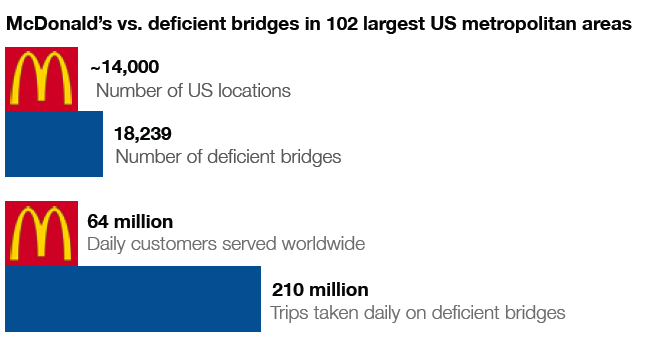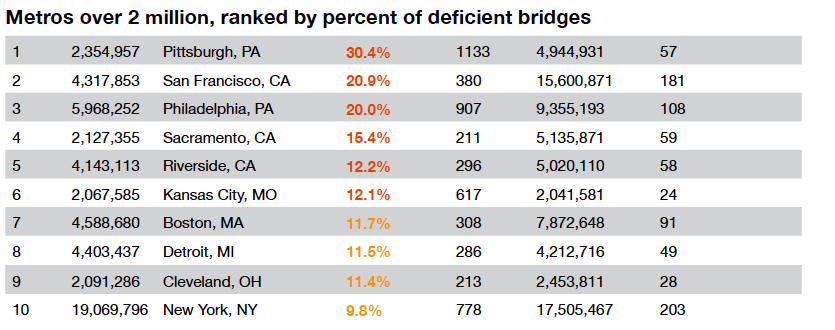TRANSPORTATION FOR AMERICA
The state of our nation’s busiest bridges
Pounded by heavy traffic day in and day out, the bridges in our metropolitan areas are indispensable links in the transportation system that takes millions of people to work and goods to market every day. And they threaten to become weak links, as they age and deteriorate in an era when public investment in infrastructure is shrinking in relative terms..
The impact of a failure to attend to our bridges became all too clear in September, 2011, when the governors of Kentucky and Indiana were forced to close the busy Sherman Minton Bridge in metropolitan Louisville after inspectors found cracks in its structural beams. The closure made national headlines as Louisville traffic was snarled and millions of Americans wondered about the condition of the busy bridges they have to cross each day.
With the majority of American bridges soon due for major maintenance, overhaul or replacement, scenarios such as this could begin playing out with increasing frequency absent concerted effort and investment.
The largest 102 metropolitan areas
Transportation for America conducted an analysis of the National Bridge Inventory, a database produced by the Federal Highway Administration (FHWA), and found one in nine U.S. bridges has been rated “structurally deficient.” This means that the bridge is in need of more frequent monitoring and critical, near-term maintenance, rehabilitation or replacement.
Structurally deficient bridges in metropolitan areas carry a disproportionate share of all trips taken on a deficient bridge each day. In fact, deficient bridges in the largest 102 metropolitan areas carry three-quarters of all traffic crossing a deficient bridge. Put another way, there are more deficient bridges in these 102 regions than there are McDonald’s restaurants in the entire country – 18,239 versus about million 14,000. Worldwide, McDonald’s serves a staggering 64 million people a day. But here in America, 210 million trips are taken daily across deficient bridges in just these 102 regions.
Pennsylvania leads all other states in the nation with six metropolitan areas with a high percentage of deficient bridges. Pittsburgh leads the way with 30 percent of area bridges rated deficient — higher even than the state average of 26.5 percent. It is important to note that these numbers would be worse without the intensive bridge repair program implemented by Pennsylvania in the last several years, including a quadrupling of state funding for bridge repairs.
California leads the nation with the busiest deficient bridges. In Los Angeles, for example, 396 cars drive across a structurally deficient bridge every second of each day, on average. When ranking metros by the sheer volume of traffic on deficient bridges, California regions take several of the top spots, with the daily volume in Los Angeles at number one, more than double that of second place New York.
Structurally deficient bridges
America’s infrastructure is showing its age. Despite billions of dollars in annual federal, state and local funds directed toward the maintenance of bridges, 69,223 bridges overall are classified as “structurally deficient,” according to the Federal Highway Administration (FHWA). Moreover, many bridges have exceeded their 50-year design lifespan. Without significant investment in repair this trend is likely to worsen as the average age of an American bridge is 42 years. According to FHWA’s 2009 statistics (the most recent year for which national data are available), $70.9 billion is needed to address the current backlog of deficient bridges.
The good news is that some states have worked hard to address the problem and have reduced the backlog of deficient bridges. The bad news is that, critical as these efforts are, they are not nearly enough.
Two key problems persist: First, while Congress has repeatedly declared bridge safety a national priority, existing federal programs offer no real incentives or assurances that aging bridges will actually get fixed. Second, the current level of investment is nowhere near what is needed to keep up with our rapidly growing backlog of aging bridges.
Download full report (PDF): Metropolitan Bridge Rankings
About Transportation for America
www.t4america.org
Transportation for America has formed a broad coalition of housing, business, environmental, public health, transportation, equitable development, and other organizations. We’re all seeking to align our national, state, and local transportation policies with an array of issues like economic opportunity, climate change, energy security, health, housing and community development.
Tags: Federal Highway Administration, FHWA, Metropolitan, National Bridge Inventory, PA, Pennsylvania, T4America, Transportation for America








 RSS Feed
RSS Feed